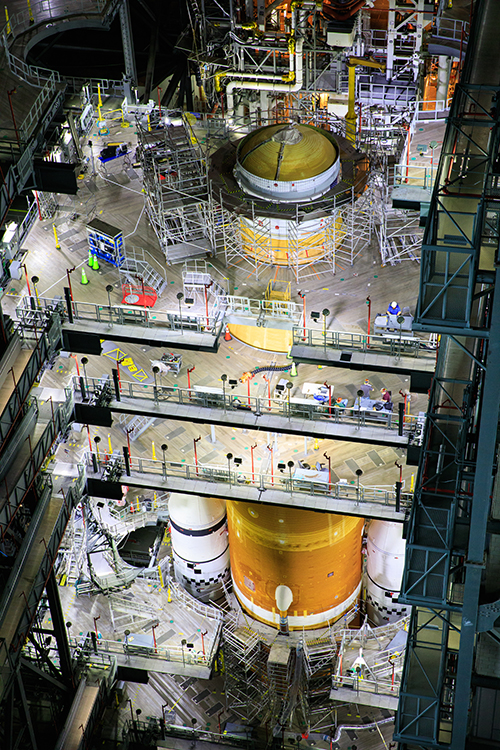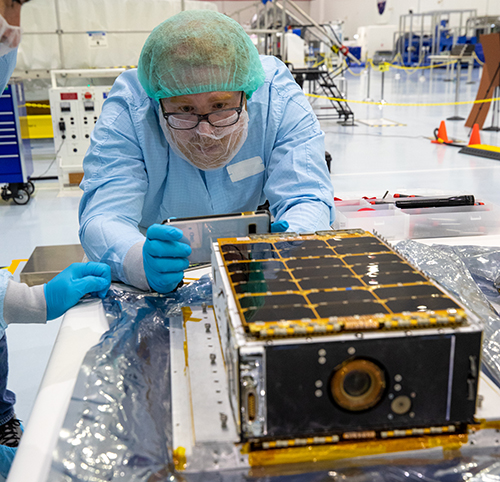College of Science
Lunar IceCube built at Morehead State delivered to NASA for Artemis I mission
 The Morehead State University team that built NASA's Lunar IceCube satellite safely delivered the spacecraft to NASA's Kennedy Space Center in Florida in preparation for a launch expected later this year on NASA's Space Launch System (SLS) Artemis I rocket.
The Morehead State University team that built NASA's Lunar IceCube satellite safely delivered the spacecraft to NASA's Kennedy Space Center in Florida in preparation for a launch expected later this year on NASA's Space Launch System (SLS) Artemis I rocket. Lunar IceCube is a small, complex interplanetary spacecraft about the size of a carry-on piece of luggage. It will be launched in November on the maiden voyage of the Space Launch System (SLS), the most powerful rocket ever built. Morehead State leads the mission in partnership with NASA Goddard Spaceflight Center, JPL, and the Busek Space Propulsion Company.
"Delivery of the spacecraft to NASA represents the culmination of seven years of development by the team," said Dr. Ben Malphrus, the principal investigator leading the mission. "It is a credit to our outstanding team of faculty and students that a small university was able to accomplish this incredible mission."
The Lunar IceCube team includes several faculty and staff members of the Space Science Center and more than 50 students at Morehead State, in addition to a small number of scientists and engineers from NASA Goddard Spaceflight Center, the NASA Jet Propulsion Laboratory, the NASA Independent Verification and Validation Center and the Busek Space Propulsion company.
Nathan Fite, a space systems engineer at the Space Science Center at MSU and the program manager, said the mission is significant.
"Lunar IceCube is one of the first of a generation of higher capability CubeSat spacecraft that represents a transition of the technology from Low Earth Orbiting (LEO) satellites to Interplanetary missions," Fite said. "The Artemis 1 missions bridge the gap between LEO CubeSats and larger interplanetary space missions."
The 14 kg probe will use a plasma drive propulsion system to take it on a circuitous route to the Moon, where it will orbit for a year and investigate the transportation physics of water ice on the lunar surface in support of a lunar outpost that NASA plans to develop.
Previous lunar missions have discovered water ice in frigid regions of the Moon called Permanently Shadowed Regions (PSRs). Lunar IceCube will investigate how much water is there and where these deposits are. NASA hopes that there is enough water on the Moon to support future human and robotic exploration of the solar system.
 Lunar IceCube's mission will last approximately 18 months and the spacecraft will perform hundreds of orbits of the Moon. The mission will be operated from the Mission Operations Center (MOC) in the Space Science Center at Morehead State University, where the spacecraft was built. The team will use NASA's Deep Space Network and Morehead State University's own 21-meter ground station antenna to send commands to the spacecraft and downlink data and telemetry.
Lunar IceCube's mission will last approximately 18 months and the spacecraft will perform hundreds of orbits of the Moon. The mission will be operated from the Mission Operations Center (MOC) in the Space Science Center at Morehead State University, where the spacecraft was built. The team will use NASA's Deep Space Network and Morehead State University's own 21-meter ground station antenna to send commands to the spacecraft and downlink data and telemetry. Lunar IceCube was among the first two CubeSats of 13 taken aboard for the Artemis I mission as secondary payload. In preparation for its mission, Lunar IceCube was integrated with a dispenser and installed in the Orion stage adapter at NASA's Kennedy Space Center in Florida on July 16. When Artemis I launches later this year, it will carry 12 CubeSats. These missions are the secondary payloads on the Artemis I mission.
Now that the spacecraft has been delivered, the team will use an engineering model of the satellite called a "FlatSat," located at MSU, to develop and test the spacecraft activities needed once Lunar IceCube is in flight. This model includes all the components on the flight spacecraft delivered to the Kennedy Space Center and runs the flight software developed in-house at Morehead State.
For more information about MSU's Space Science Center, visit www.moreheadstate.edu/ssc.
To learn about MSU's space systems engineering program, visit www.moreheadstate.edu/study/spacesystemsengineering, email phes@morheadstate.edu or call 606-783-2381.
The Lunar IceCube mission is supported by NASA’s Advanced Exploration Systems (AES) and NASA’s Human Exploration and Operations Mission Directorate.
Photo Credit: NASA
Top Photo: The Artemis I spacecraft is currently being assembled at the Kennedy Space Center and will carry the Lunar IceCube as a secondary payload.
Bottom photo: Nathan Fite, MSU instructor of space systems engineering, conducted final testing on the Lunar IceCube after it was delivered to the Kennedy Space Center in Cape Canaveral, Florida.
